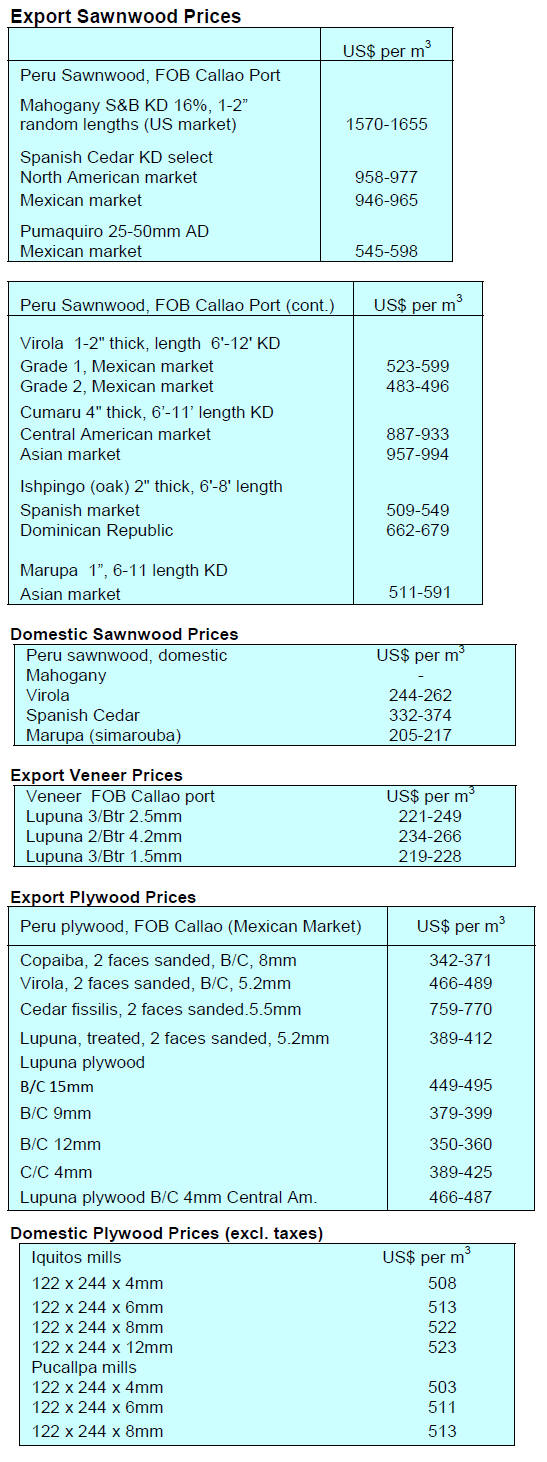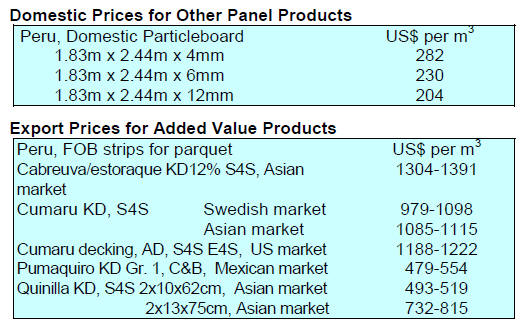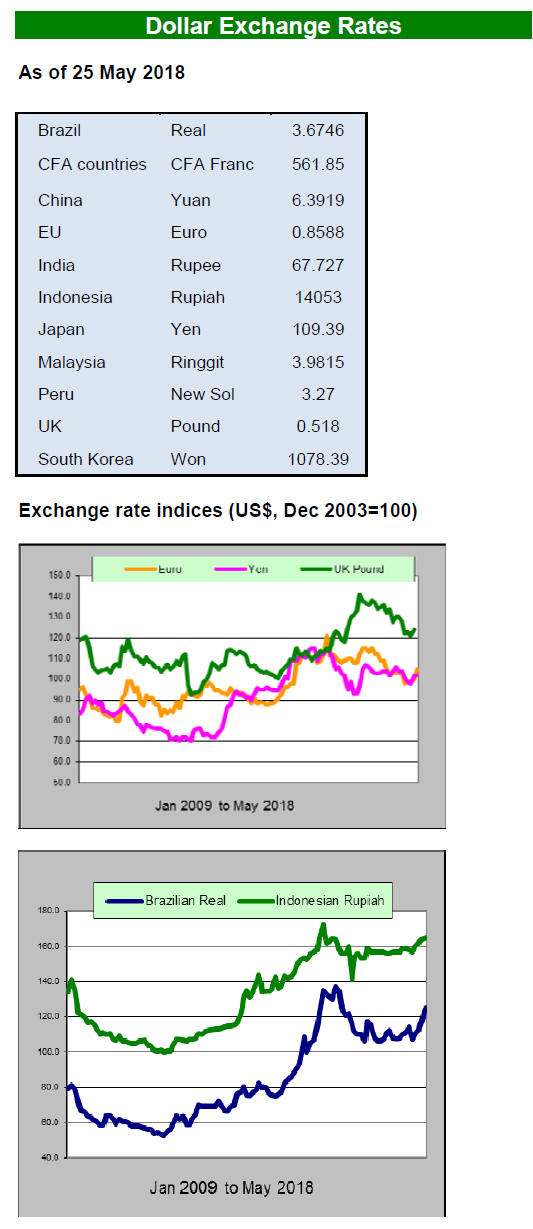2. GHANA
Manufacturers told - Be more innovative
The Deputy Trade and Industry Minister, Robert Ahomka-
Lindsay, has reminded enterprises in the country that the
government aims to lift the level of industrialisation and
has called upon domestic companies to be more innovative
so they can raise competiveness in the domestic and
international markets.
Expansion of the manufacturing sector is at core of
government plans to drive the economy and wean it off
the dependence on aid. This is part of the Presidents dream
of a Ghana ‘Beyond Aid’.
For its part, the timber sector is forging ahead with efforts
to export a higher proportion of added value wood
products.
Port expansions welcomed
The Ghana Ports and Harbours Authority (GPHA) is
investing heavily in a programme to modernise the
country’s port facilities and operations as well as expand
port capacity.
In recent years, because of the strategic location and
business friendly environment, several shipping
companies and trading houses have opened offices in
Ghana from which they manage operations along the West
African coast. The GPHA has indicated that it aims to
triple annual port capacity by mid-2019.
Forestry sector needs stimulus to recover
Timber enterprises are growing increasingly concerned
about the declining availability of timber raw materials
and are calling on the government to expand efforts on
reforestation. The other major problem facing the timber
industry is the lack of skilled workers.
In a related development, participants at a global forestry
conference, have called on African governments to reverse
the declining trend of deforestation on the continent where
reports say between 2010 and 2015 Africa recorded the
highest net annual loss of forests which was attributed
mainly to subsistence farming.
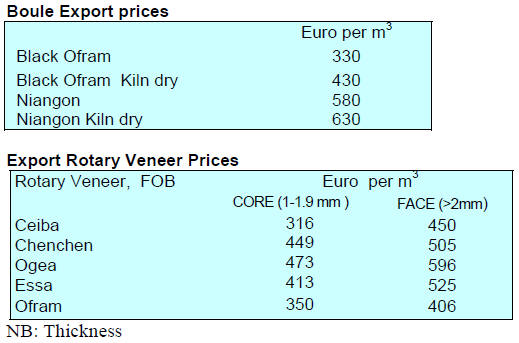
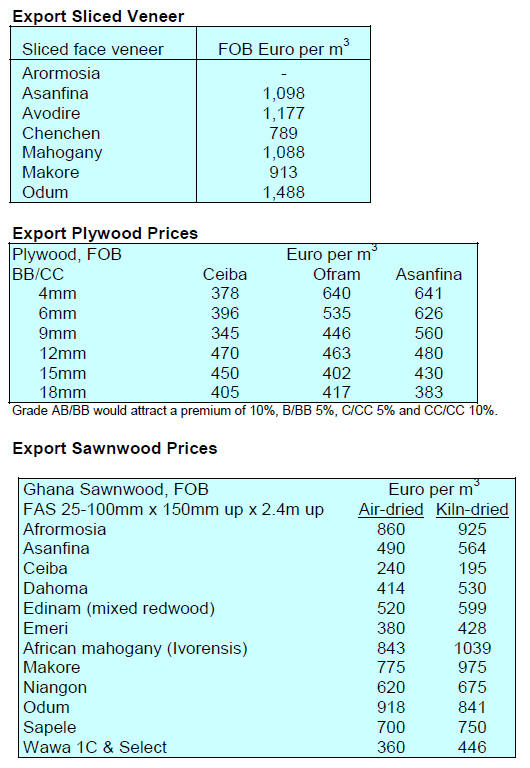
3.
MALAYSIA
Sabah ban log exports
The export of logs from Sabah, a major timber producing
state, has been banned with immediate effect.
The recently elected Chief Minister, Mohd Shafie Apdal,
said the move was taken to ensure sufficient timber for
mills in the State and secure jobs. The steady decline in
availability of natural forest logs is behind this ban, say
analysts.
In recent years Sabah exported between 200,000 and
300,000 tonnes of logs to countries such as China, Japan,
Philippines and India.
James Hwong You Chuaang, President of Sabah Timber
Industries Association (STIA), welcomed the ban saying
this long awaited measure will help revive the timber
industry in the State where many mills have been forced
out of business because of a log shortage.
It is the uncertainty over log supply that has held back
investment in downstream manufacturing said Hwong.
The members of the STIA hope this ban will be the
beginning of a new era in the timber industry in Sabah.
Malaysian companies urged to use Rotterdam as hub
for European trade
The Malaysian Timber Council (MTC) in cooperation
with the Netherlands Foreign Investment Agency (NFIA)
recently held a seminar themed “The Netherlands: Your
Base for Malaysian Timber and Wood Products Exports to
Europe” .
The seminar brought together key speakers from
Malaysian industry and the Netherlands who spoke on
facilities and incentives provided to investors by the Dutch
government. At the seminar MTC Chairman, Datuk Gooi
Hoe Hin, touted Malaysia as a strategic partner with the
Netherlands in reaching the Netherlands target of securing
90% of certified tropical timber products by 2020.
Currently the Netherlands accounts for about 30% of
Malaysia’s exports of certified timber and timber products
worth around RM435 million last year. Representatives
from NFIA, the Holland International Distribution Council
(HIDC) and the International Port of Rotterdam promoted
the Netherlands as an ideal European trade hub.
No news yet of governments plans for forestry
Calm has returned to Malaysia after the recent general
election which saw the ruling party of over 60 years
replaced by an opposition coalition.
Malaysia is a federation of 13 states and three federal
territories and forestry is the responsibility of the states not
the federal government. Under the new political
administration three states are controlled by the (now)
opposition party, this includes Sarawak a major timber
producing state.
The Federal Cabinet is currently being formed and it is
still too early to know of any changes, if any, to the
direction on national forest policy or policies affecting the
timber industries.
Sarawak Plywood prices.
Traders based in Sarawak reported the following export
prices of plywood:
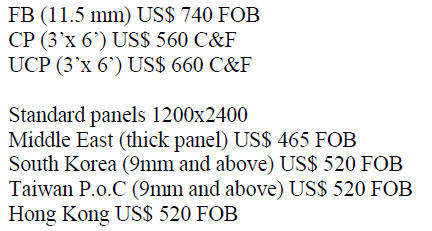
4.
INDONESIA
Mills maintain output despite
recent dip in log
production
The Chairman of the Indonesia Sawmill and
Woodworking Association (ISWA) has said exports by
members of the Association in the first quarter of this year
were around the same as in the same period last year.
Data compiled by the Association show exports in the first
quarter of 2018 at approximately 1 million cubic metres
worth US$550.5 million. This was significant he said as
there was no major impact from the decline in natural
forest log production.
Last year exports of processed wood products amounted to
just over 4 million cubic metres worth US$2 billion
(FOB). Exports of BareCore contributed most in volume
to 2017 exports (1.9 mil. cu.m). BareCore is a panel
comprised of strips of solid wood glued together and
commonly utilises Albizia falcata.
However, in terms of value, moldings contributed the
most, US$727.5 million. China was the main market
importing some 2 million cu.m worth US$637 mil. in
2017.
Furniture companies still suffer domestic regulatory
hurdles
Indonesian furniture and handicraft manufacturers are
seeking assistance from the government to urge local
governments to implement government directives on
deregulation of production.
The Vice Chairman of Association of Indonesian
Furniture and Handicraft Industry (HIMKI), Wiradadi
Suprayogo, said that many members complain that
regulatory obstacles are still being encountered despite the
many changes that have been introduced aimed at easing
the burden on enterprises and these amount to non-tariff
barriers for the local industry.
In addition, the Association is questioning the logic of
imposing SVLK certification on enterprises which utilise
already SVLK certified raw materials.
State of Indonesia`s Forest – a new publication
launched
The Ministry of Environment and Forestry has announced
it will publish the first ‘State of Indonesia`s Forests’ in
collaboration with FAO.
The publication will highlight efforts by the government to
promote good governance and sustainable forest
management in Indonesia.
The Minister of Environment and Forestry, Siti Nurbaya,
who will be the editor of this publication, said this is a
huge step forward for Indonesian forestry.
See:http://indonews.id/artikel/13411/KLHK-dan-FAO-Susun-
Dokumen-Status-Hutan-Indonesia/
Speedy VAT refund would aid industry
Wood product exporters are calling on the government to
speed up the process of VAT refunds to boost the
competitiveness of the national plywood industry.
Gunawan Salim, of the Indonesian Wood Panel
Association (Apkindo) said the 10% VAT on roundwood
purchases is a burden for the plywood industry where log
costs can make up as much as 60% of production costs.
In Indonesia the VAT can be refunded when processed
products are exported but at present it taks the government
agency responsible around one and a half year to process
refunds. Apkindo has repeatedly submitted proposals to
accelerate refunds.
Ministry of Trade - No to log exports this year
The domestic press is reporting that, according to Tuti
Prahastuti, Director of Export of Agricultural and Forestry
Products, the Ministry of Trade has no plans to allow log
export this year despite the request from the Ministry of
Environment and Forestry.
A review will be conducted by the Coordinating Ministry
of Economic Affairs according to Tuti. The main concern
is that natural resources should be utilized for the
manufacture and export of downstream products.
Resistance to the log export proposal has come from
furniture and wood product manufacturers who fear a
decline in availability will lead to a surge in log costs as
export logs attract high prices.
Log production set to rise
The Executive Director of the Association of Indonesian
Forest Concessionaires (APHI), Purwadi Soeprihanto, has
reported that first quarter 2018 log production was 10.62
million cubic metres, only slightly down on the level in the
same period in 2017 (10.95 million cubic metres).
The dip in 2018 first quarter production was the result of
bad weather which hampered logging according to
Purwadi.
APHI is forecasting that roundwood production will
increase from April when the dry season sets in and
production will rise as log prices at present are good.
APHI has suggested that roundwood production this year
will be around 10% more than last year.
Export market data
In 2017 the value of exports to Asian and North American
markets accounted for over 80% of total exports.
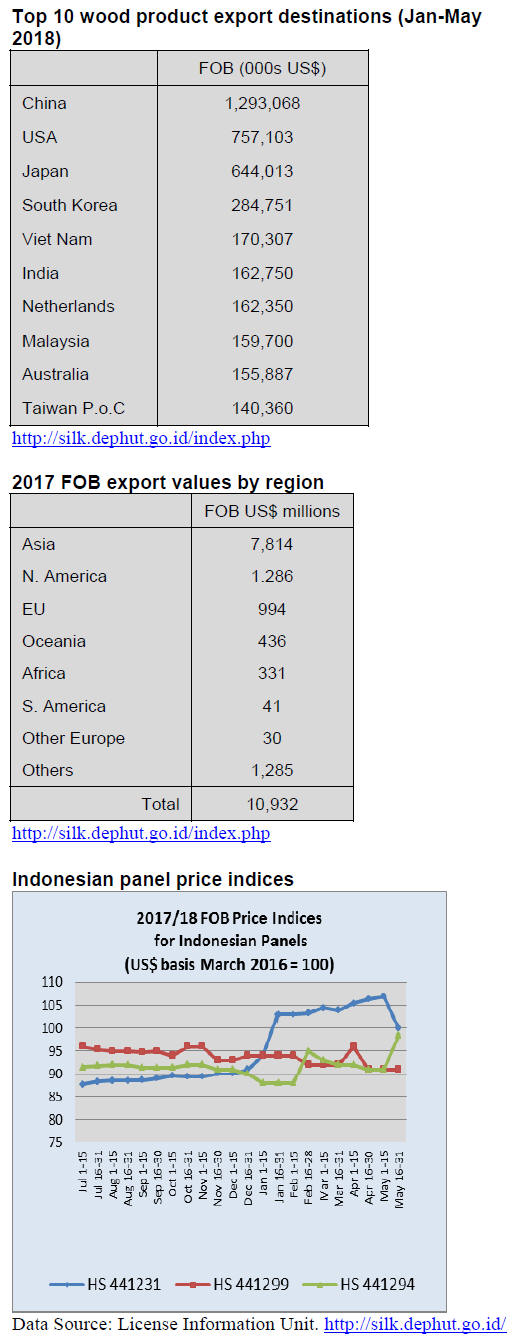
5.
MYANMAR
Myanmar to adjust dates of
fiscal year
The Myanma Timber Enterprise (MTE) intends to sell
about 440 h.tons of teak logs and about 9,500 h.tons of
non-teak logs each month between April and September
this year.
Myanmar has revised the system for the beginning and end
of the fiscal year which currently runs 1 April to 31
March. In future the fiscal year will begin 1 October and
end 31 September. The announced sale of timber by MTE
(mentioned above) has been arranged to facilitate
transition to the new beginning and end of the fiscal year.
Plantation teak logs scheduled for sale in the next fiscal
year are between 35 and 100 year-old. The projected
annual allowable cut (AAC) is around 19,000 trees for
teak and 600,000 trees for non-teak hardwoods. The
targeted annual production is just about 7,500 teak trees
and 160,000 non-teak trees.
Rising non-teak hardwood prices
The price of fresh inn-kanyin ( gurjang/keriung) logs has
recently surged to over US$1,000/h.ton because of the
high demand from the plywood mills. For many years the
prices for these timbers was stable in the range from
US$600 to US$800/h.ton.
Export update
For fiscal 2017-18, which ended on 31 March 2018,
exports of forest products earned US$212 million, of
which some US$2.68 million was from the border trade
according to the Ministry of Commerce.
Working elephants earn their keep in tourism camps
As a result of the log export ban the elephants trained for
log harvesting have no work so the management of
MTE converted some elephant camps into elephant
conservation-based tourism camps in a bid to generate
revenue to support the elephants and their handlers
(mahouts).
The government-run Myanma Timber Enterprise earned
about Kyat430 million (approx US$325,500) since it
began operating conservation-based tourism camps around
the country two years ago.
MTE has 3,078 elephants of which 514 are under 4, 734
are between 4 and 18 and 1,597 are 18 to 55 years old, the
rest are retired elephants.
Plans to restructuring MTE with private sector
management
After the log export ban came into force in 2014
harvesting of both teak and non-teak has been drastically
reduced and reforestation and forest restoration
programmes have been implemented.
This development had a big impact on MTE and made the
management and government start to consider a new
business model.
But the legal ramifications of changing MTE are
complicated. Analysts write that it appears MTE will be
restructured as a corporation within government but with
private sector management.
However, these changes have to be made through a State
Corporatisation Law which is still under discussion and
may not be enacted by 2020 when the term of current
government ends.
Minimum wage hiked
The government has announced a new daily minimum
wage of K4,800 raising the minimum negotiated in 2015
which in itself was a landmark for labour market reform in
the country.
Although Myanmar has not ratified the International
Labour Organization’s Minimum Wage Convention 131,
the new minimum in Myanmar largely reflects the ILO
recommendations.
The latest adjustment was negotiated through an open and
transparent process of tripartite social dialogue between
the government, representative employers and workers’
organisations.
6. INDIA
Plywood price index flat in April but
prices have now
risen
India’s official wholesale price index for all commodities
(Base: 2011-12=100) for April 2018 released by the Office
of the Economic Adviser to the government rose to 116.8
from 116.0 for March.
The annual rate of inflation, based on monthly WPI in
April 2018 was 3.18% compared to 2.47% for the previous
month.
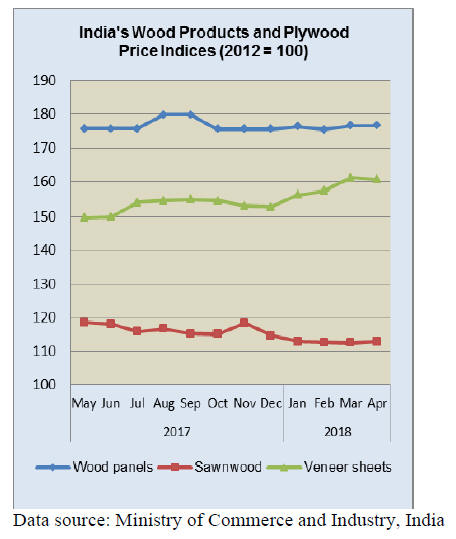
The index for Manufacture of Wood and of Products of
Wood and Cork group declined by 0.1 percent to 131.6
from 131.7 for the previous month due to lower price of
plywood, blockboard and wooden box/crate (1% each).
However, the price of particleboard moved up. In early
May domestic manufacturers lifted prices for plywood.
The press release from the Ministry of Commerce and Industry
can be found at:
http://eaindustry.nic.in/cmonthly.pdf
Rupee under pressure
The rupee/dollar exchange rate in mid-May was down to
almost its all-time low of 68.825 recorded in August 2013.
The rupee has fallen over 6% against the US dollar this
year making it the most vulnerable Asian currency.
Analyst fear that another increase in crude oil prices will
create added pressure on the rupee and may increase
inflationary pressures and lower the chances of an interest
rate cut by the Reserve Bank of India.
The Indian economy benefitted from the low oil prices in
the past 2-3 years but the advantages this brought are now
fading fast. From an average of around US$46/barrel in
2016 prices climbed to US$56/barrel in 2017 and averaged
over US$65/barrel in April this year and prices seem set to
rise further as especially if the US pulls out of the Iran
nuclear deal.
High oil prices will undo much of the gains in managing
the fiscal and current account deficits as this would impact
consumer sentiment, consumption and investments.
Sale of red sanders in Andhra Pradesh
The following quantities were sold on different days of the
Andhra Pradesh auction; 24 April, 94.21 tonnes of A
grade, 26 April 124.8 tonnes of A grade and on 3 May one
lot of 14.898 tonnes of A grade were sold.
While the prices for the most recent sale have not yet been
released, prices at an earlier sale were as follows:
A grade, Rs 1.95 crore per tonne, grade B prices ranged
from Rs155.35 lakh to Rs48.45 lakh per tonne while for
grade C prices ranged from Rs40.72 lakh and Rs15.15
lakh per tonne. (One Crore =10 million and 10 lakh =1
million)
Analysts point out that by managing the sale of this
valuable timber the government can undermine the black
market in red sanders and a sustainable trade can be
created. Prices at the recent sale reflect the rarity of this
timber but prices may fall when the Australian plantations
of red sanders come onto the market. Australia is said to
have around 7,000 hectares of red sanders.
Grading red sanders
The central government has developed guidelines for
grading of red sanders based on the experience gained
from sales in Andhra Pradesh.
Best quality
-Straight or nearly straight
-Minimum length of 75 cms
-Top end girth of 36 cms or above.
The logs are further graded into A, B, C or D (Non-Grade)
according to the following characteristics.
A-Grade (priced above Rs1 crore per tonne)
- Sound or nearly sound with few or no defects
-Surface gives a ripple reflection
B and C grades range between Rs.50 lakh and Rs 1 crore
per tonne
B Grade
-Semi-sound A grade logs but with more defects
-A grade logs with bends
-Logs with some defects
-Logs with medium long and medium deep wavy grain
clearly visible
C-Grade
-Long and shallow wavy grain or straight grain
-Logs sound or semi-sound with some or no defects
-Utilisable A-grade logs with many defects
-Utilisable B-grade logs with many defects
D Grade: Utilisable logs of all grades (depends on highest
price)
Plantation teak prices
Demand for imported logs remains steady but log arrivals
are still affected by the withdrawal of importers credit
facilities. In addition, the exchange rate for the Indian
rupee against the US dollar has been sliding.
Recently, the rupee slid around 5% against the US dollar
making imports more expensive. Analysts say the credit
crisis should be overcome the end of July. C&F prices
remain unchanged.
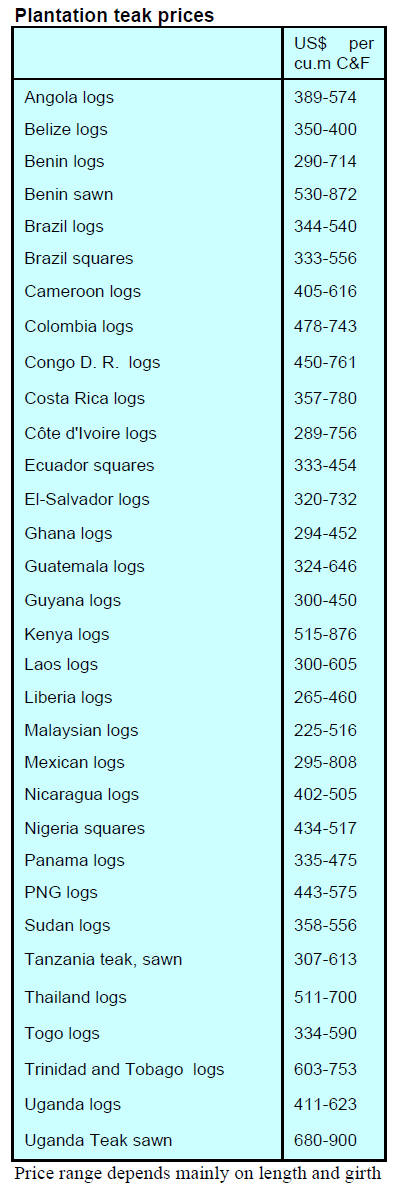
Locally sawn hardwood prices
Prices remain flat with importers saying competition is
stiff amongst traders as alternative and cheaper timbers are
on offer and are gaining market acceptance.
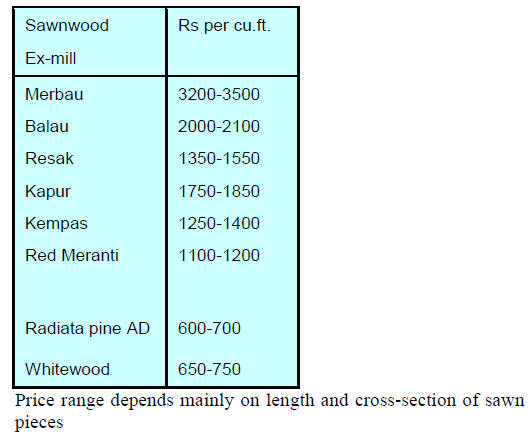
Imported sawn Myanmar teak
Trade circles report that more and more endusers are
moving away from Myanmar teak as cheaper alternatives
have been found to be good enough. The other issue is
supply. Indian traders say given the situation in Myanmar
it is unlikely that the volumes of both sawn teak and
veneers can be increased in the medium term.

Prices for imported sawnwood
Prices for imported sawnwood (KD 12%) ex-warehouse
remain unchanged.
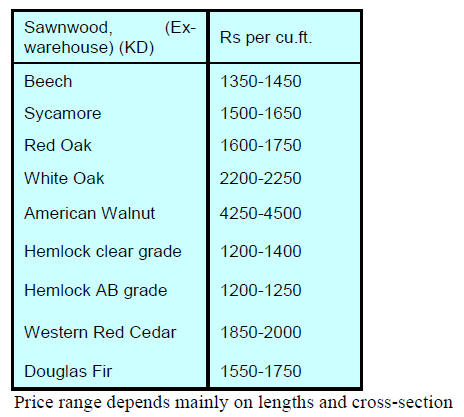
Domestic plywood update
Composite panels continue to eat into markets that
previously were dominated by plywood. Domestic
plywood manufacturers are facing the dual problems of
rising raw material costs especially for imported veneers
as well as a severe shortage of labour. Both are having a
major impact on production and profitability.
Domestic mills recently felt compelled to raise prices
despite the very negative response by the market.
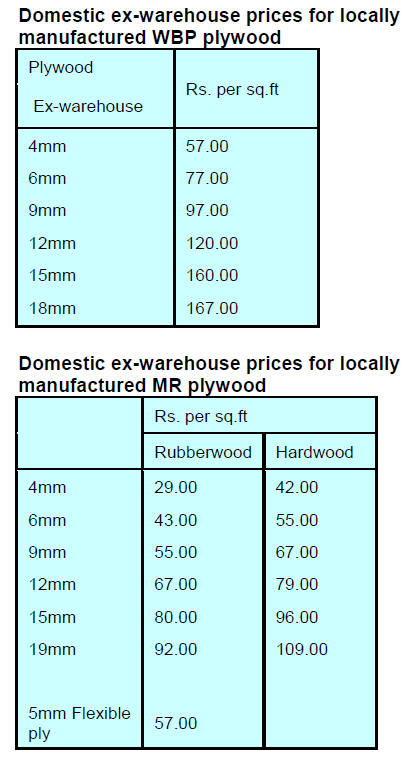
7. BRAZIL
Brazil as source of timber for
CLT production
The global market for cross-laminated timber (CLT) is
expected to be worth around US$2 billion by 2025
according to a new report published by Grand View
Research, Inc. One of the factors driving this will be an
increase in the building of wooden homes.
https://www.grandviewresearch.com/press-release/global-crosslaminated-
timber-market
The press release from the research company says rising
awareness about the environmental hazards caused by
the use of cement concrete in infrastructure construction
coupled with rising number of cross laminated timber
manufacturers and increasing demand for green homes
are factors propelling the market growth.
The shift from concrete-based construction to woodbased
construction around the world is positively
influencing the market. In addition, the cost
effectiveness of CLT and shorter construction time will
drive demand.
Europe was the first to investigate cross laminated
timber and research. The availability of timber from the
forests of central European countries and advanced
timber processing industries are the leading cause for
market growth in Europe. Countries like Canada, the
U.S., New Zealand, Japan and China are also rapidly
developing markets for cross laminated timber.
This development could benefit Brazil say analysts
because plantations in Brazil mature quickly and are a
good source of raw material for CLT production.
Resumption of investments in civil construction
The National Meeting of the Construction Industry (ENIC)
held in mid-May in Florianopolis, Santa Catarina,
discussed the importance to the economy of reviving the
civil construction sector.
Representative of the wooden door manufacturing sector
participated in the event since they were particularly
interested in the recovery of investment in civil
construction.
In a side event organized by the Quality Programme for
Wooden Doors for Buildings (PSQ-PME), entrepreneurs
and representatives of the Brazilian Association of the
Mechanically Processed Timber Industry (ABIMCI)
presented the work carried out under the programme for
the development of wooden door production supply chains
and brands that has led to product certification by the
Brazilian Association of Technical Standards.
The PSQ-PME works to promote the improvement of the
quality of wooden doors in Brazil through strengthening
the sector and raising competitiveness amongst
manufacturers as well as through improvements and
guarantees for consumers.
Export update
In April 2018, the value of Brazilian exports of woodbased
products (except pulp and paper) increased 30%
compared to April 2017, from US$221.0 million to
US$287.0 million.
Pine sawnwood export values rose 28.5% between April
2017 (US$38.3 million) and March 2018 (US$49.2
million). In terms of volume, exports increased 24% over
the same period, from 187,700 cu.m to 233,000 cu.m.
Tropical sawnwood exports increase 49% in volume, from
31,000 cu.m in April 2017 to 46,200 cu.m in April 2018.
The value of this trade increased 42% from US$14.2
million to US$20.2 million over the same period.
Pine plywood exports also increased, jumping 68% in
value in April 2018 in comparison to April 2017, from
US$40.6 million to US$68.3 million.
The volume of exports increased 35% over the same
period, from 146,800 cu.m to 198,500 cu.m.
As for tropical plywood, exports increased in value from
US$5.4 million in April 2017 to US$6.1 million in April
2018.
To cap off a good month, wooden furniture exports rose
from US$38.2 million in April 2017 to US$45.3 million in
March 2018 an almost 19% rise.
In the three main markets for Brazil’s furniture sales
improved in the first four months: the United States
(+20%), the UK (+10%) and Argentina (+9%). It is
encouraging that importers in Argentina have increased
purchases after three consecutive years of decline. The
three main markets represent 47% of the country's total
sales in the first four months of this year.
The States of Santa Catarina and Rio Grande do Sul
continue to provide the bulk of Brazilian furniture. The
value of year on year export sales by manufacturers in
Santa Catarina expanded 16% in the first four months of
this year. The comparable figure for manufacturers in Rio
Grande do Sul was +12%.
Brazil’s furniture imports expanded over 20% in the first
four months of this year compared to the same period in
2017 rising to US$193.4 million, of which 37% came from
China.
Search for new timber markets
In search of new markets and technologies a group of
entrepreneurs from Mato Grosso will visit Carrefour Du
Bois to be held in Nantes 30May to 1 June.
The Directors of Center for Wood Producing and
Exporting Industries of Mato Grosso (CIPEM) have said
they expect to establish business contacts for new markets
so as to increase exports from Mato Grosso state.
Analysts write “there is a great potential in external market
for the products produced in Mato Grosso as European
consumers appreciate timber from natural forests. With the
adoption in Brazil of chain of custody tracking the
credibility of the sector has becomes more transparent
opening up new market opportunities”.
The forestry sector represents the main economy of 44
municipalities in the state of Mato Grosso. In addition, the
sector ranks in the 4th in the state economy.
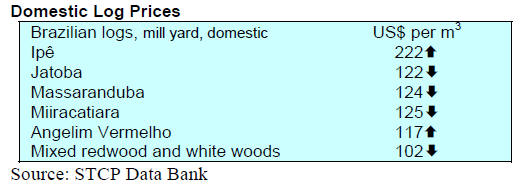
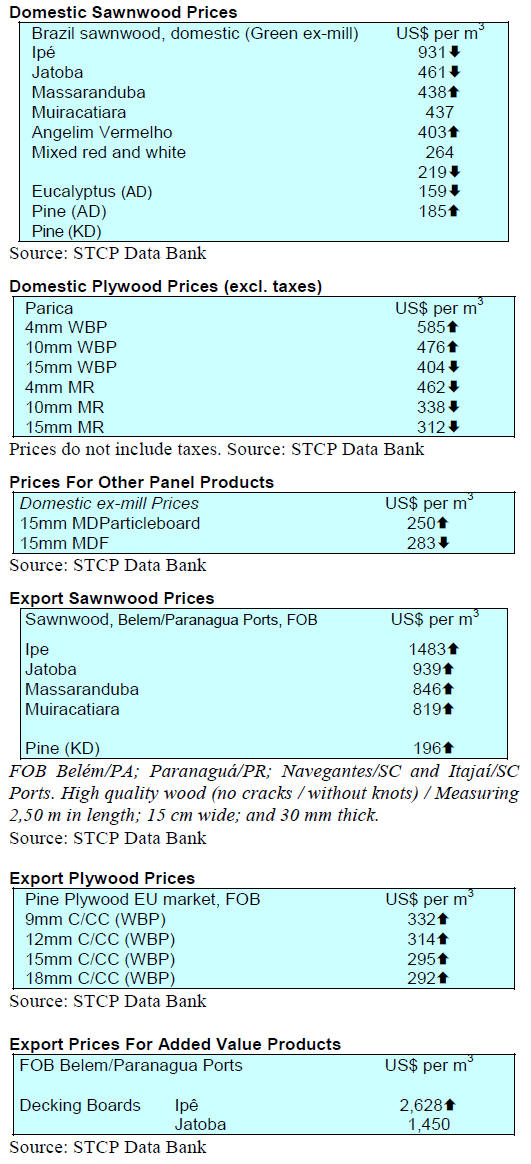
8. PERU
IKEA to expand into Peru
IKEA is ready to expand into South America with outlets
planned in three countries including Peru. To ensure the
success of this expansion Ikea will partner with the
Chilean retailer Falabella.
IKEA has announced it will open a regional warehouse in
Santiago in 2020 and expand into Lima and Bogotß.
In a press release, Torbj÷rn L÷÷f, CEO of the Inter IKEA
Group said “We are of course very excited to bring IKEA
to South America together with Falabella, who is a strong
local partner with a lot of experience in developing and
successfully operating retail businesses.
They also have a well-developed distribution network in
the region, which will give us the speed we need to be
more accessible to the many. Together we’ll work to make
IKEA a loved and meaningful brand for the people in
Chile, Colombia and Peru.”
IKEA has around 1.2 billion customers which the
company expects to increase to 3.2 million customers by
2025.
For more see:
https://newsroom.inter.ikea.com/News/ikea-meets-customers-ona-
new-continent/s/77174369-a796-441c-a4b6-2b5364460a80
Mission to IWF USA Fair 2018
In August the consulting company Tropical Forest will
organize a trade mission to the International Woodworking
Fair (IWF) 2018 fair to be held in Atlanta.
This fair is a major event for suppliers of technology,
equipment and accessories for the wood processing and
furniture manufacturing sectors.
Peru’s forestry sector attracting foreign investors
Drago Bozovich, CEO of Maderera Bozovich, has said he
was aware of increased acquisitions of domestic
enterprises by foreign investors who are attracted by
opportunities in the wood processing industries and by the
revamped legal framework that now supports the sector.
According to Bozovich, production in 2017 was badly
affected by abnormal weather conditions in the country
but that in early 2018 production levels had returned to
normal.
Carbon credits from conservation projects
The authorities in Peru have begun moves to designate
forestry conservation projects as contributors to meeting
international climate targets and have announced REDD+
carbon credits from two projects in Peru will be
acknowledged by the Ministry of Environment.
The Business Green website says carbon credits generated
by the Tambopata-Bahuaja Reserve and Cordillera Azul
National Park REDD+ conservation projects will be
integrated into its nationally determined contribution
(NDC) climate action plan under the Paris Agreement.
For the full story see:
https://www.businessgreen.com/bg/news/3032624/peru-movesto-
integrate-redd-forest-conservation-projects-into-paris-climateplan
